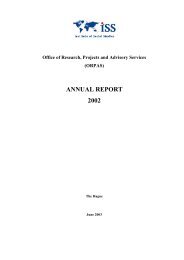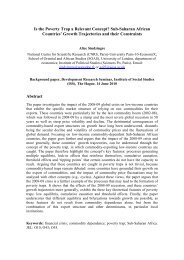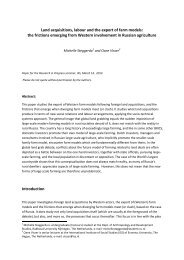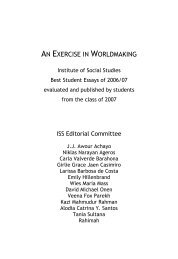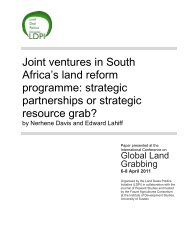AN EXERCISE IN WORLDMAKING 2009 - ISS
AN EXERCISE IN WORLDMAKING 2009 - ISS
AN EXERCISE IN WORLDMAKING 2009 - ISS
Create successful ePaper yourself
Turn your PDF publications into a flip-book with our unique Google optimized e-Paper software.
102 BERNICE CAMPOS ROLD<strong>AN</strong><br />
grams that emphasized savings over loan provision’. Trustworthiness of<br />
MFIs was a priority for both clusters, as ‘existing and potential clients do<br />
not automatically consider MFIs trustworthy’.<br />
There was fairly equal use of loan and savings withdrawals both for<br />
consumption and business investments. A significant number took out<br />
loans to repay old debts, a practice considered taboo by most MFIs.<br />
There is a clear disconnect between the microfinance characteristics preferred<br />
by the poor, particularly flexibility of financial services, and the<br />
services and products offered by MFIs. As Hickson states, ‘The extent to<br />
which poor households seek this flexibility is not often appreciated by<br />
MFIs, or if it is, these demands are usually dismissed as unrealistic and<br />
impracticable’.<br />
SELF-HELP <strong>AN</strong>D ‘NO-HELP’<br />
In India, the typical form of credit provision is through self-help groups<br />
(SHGs), defined as microcredit-based groups where women access and<br />
repay loans as a collective. Supporters assert that the groups make credit<br />
accessible and create inroads towards poverty alleviation and women’s<br />
empowerment. These collectives, borne out of class-based struggles and<br />
the autonomous women’s movement, evolved over recent decades based<br />
on principles of solidarity and collective action. In the 1970s, pioneering<br />
NGOs used SHGs as a means of organizing poor communities in the<br />
southern states of India (Nirantar, 2007: 4-6).<br />
Self-help, like microcredit, has its peculiarities. Promoting self-help<br />
among the poor is encouraged as it ‘creates respect for poor people’s<br />
capability and creativity, and modesty on the side of development “experts”’<br />
(Berner and Phillips, 2005: 19). But community self-help is nothing<br />
new. It is characterized as ‘the default strategy of the poor’, and the<br />
attention given to self-help by international development agencies such<br />
as the World Bank may be seen as ‘masking defense against calls for redistribution’.<br />
The authors cite the case of the Bank, which ‘still dismisses<br />
redistribution as usually “leading to political upheaval and violent conflict”,<br />
ignoring the findings of consulted experts who had stated that<br />
growth with some redistribution has the largest impact on poverty’<br />
(World Bank, 2000: 56 f., in Berner and Phillips, 2005: 19, emphasis in<br />
the original). Promoting self-help would be in the interest of those trying<br />
to cover up a ‘no-help’ attitude.




